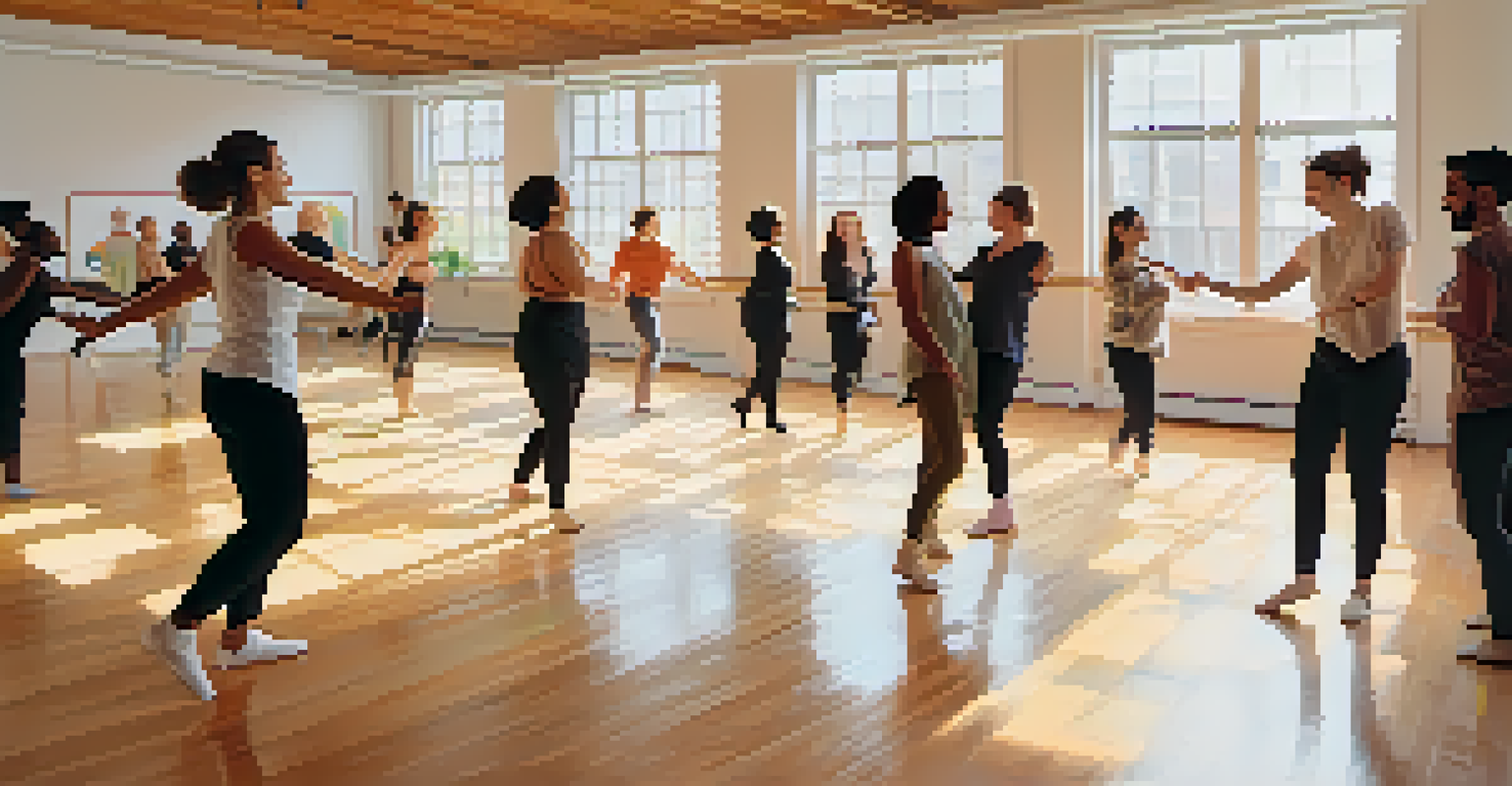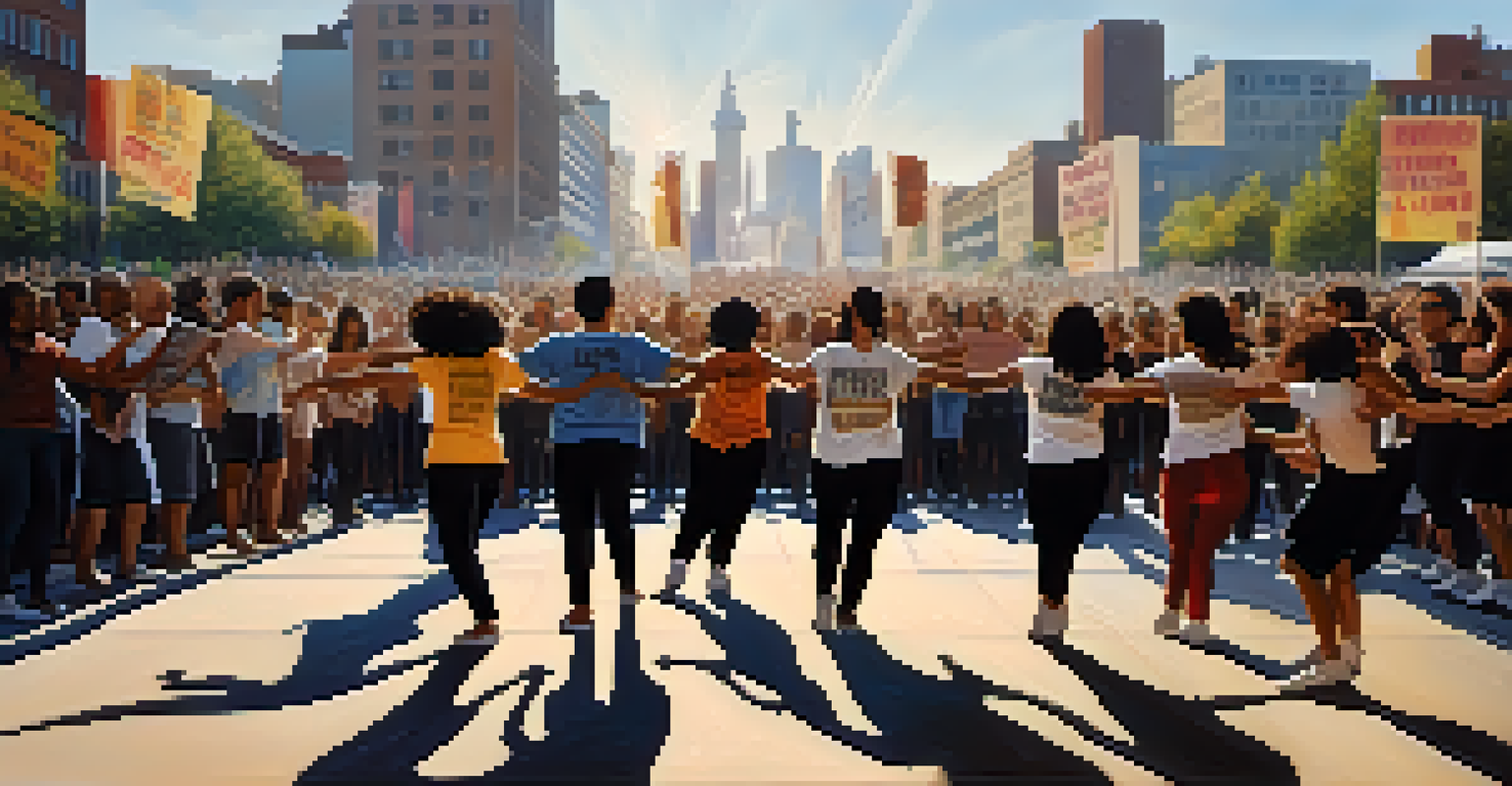The Influence of Dance in LGBTQ+ Rights Movements

The Historical Roots of Dance in LGBTQ+ Culture
Dance has long been a cornerstone of LGBTQ+ culture, with its roots tracing back to early celebrations of identity and community. From the ballroom scenes of the 1920s to the vibrant drag performances in contemporary settings, dance has served as a form of expression and resistance. These gatherings provided safe spaces where individuals could explore their identities freely, away from societal judgment.
Dance is the hidden language of the soul.
During the 1960s and 70s, dance became a radical act of defiance amid the oppressive climate faced by LGBTQ+ individuals. Events like the Stonewall Riots, often marked by dancing and revelry, highlighted the importance of joy in the fight for rights. The rhythm of the dance floor echoed the pulse of the movement, symbolizing resilience and unity.
Today, dance continues to be a powerful medium through which LGBTQ+ stories are told, contributing to a rich cultural legacy. Whether through flash mobs or choreographed protests, the language of dance remains a potent tool for advocacy, inviting people to join in solidarity and celebration.
Dance as a Form of Protest and Activism
Throughout history, dance has emerged as a powerful form of protest, allowing marginalized communities to express their frustrations and aspirations. From the expressive movements of AIDS activism in the 1980s to modern flash mobs advocating for marriage equality, dance has captured attention and sparked conversations. This form of activism transforms public spaces into stages for change, engaging audiences in unexpected ways.

Consider the Dance for Justice movement, where choreographed performances address issues like police brutality and discrimination. These events combine artistic expression with a call to action, creating a powerful visual statement that resonates deeply with viewers. By blending art and activism, dance can bridge gaps between diverse communities, fostering understanding and empathy.
Dance as Resistance and Expression
Throughout history, dance has served as a powerful form of expression and resistance for the LGBTQ+ community, particularly during pivotal moments of activism.
Moreover, the inclusive nature of dance encourages participation from all, regardless of skill level. This accessibility transforms dance into a collective experience, where individuals unite for a common cause, amplifying their voices and messages. As people come together to dance, they create a sense of belonging and solidarity that strengthens the movement.
The Role of LGBTQ+ Icons in Dance
LGBTQ+ icons in the dance world have played a significant role in elevating the visibility of queer identities and issues. Artists like Madonna and RuPaul have not only popularized dance but also used their platforms to advocate for LGBTQ+ rights. Their performances often challenge societal norms, pushing boundaries and encouraging others to embrace their authentic selves.
To be yourself in a world that is constantly trying to make you something else is the greatest accomplishment.
Choreographers and dancers such as Alvin Ailey and Pina Bausch have also contributed to this movement by infusing their work with themes of identity, love, and struggle. Through their innovative techniques and storytelling, they have opened doors for greater representation within the dance community. This representation is crucial, as it inspires future generations to pursue their passions fearlessly.
These icons remind us that dance is more than just art; it’s a vehicle for change and a source of inspiration. Their influence continues to motivate LGBTQ+ individuals to express themselves and advocate for their rights, proving that the dance floor can be a powerful stage for social justice.
Dance in LGBTQ+ Celebrations and Pride Events
Pride events around the world have become synonymous with dance, serving as joyous celebrations of identity and community. The vibrant parades feature dancers showcasing their talents, often accompanied by music that uplifts and empowers participants. These celebrations not only honor the struggles of the LGBTQ+ community but also provide a space for joy and self-acceptance.
Events like the New York City Pride March see dancers from various backgrounds coming together to celebrate love and diversity. The electric atmosphere encourages individuals to express themselves freely, creating a powerful sense of belonging. The dance floor at these events becomes a sanctuary, where people feel safe to celebrate their identities without fear of judgment.
Icons Amplify LGBTQ+ Visibility
Prominent LGBTQ+ icons in dance have significantly elevated the visibility of queer identities, using their platforms to advocate for rights and inspire future generations.
Moreover, dance performances at Pride events often carry significant messages about activism and unity. Choreographed routines can highlight important issues, reminding attendees of the ongoing fight for equality while fostering a spirit of togetherness. This blend of celebration and advocacy demonstrates how dance can be a unifying force in the LGBTQ+ movement.
The Impact of Dance on Mental Health in the LGBTQ+ Community
Dance serves as a therapeutic outlet for many within the LGBTQ+ community, offering a way to process emotions and experiences. Engaging in movement can reduce stress and anxiety, providing a sense of relief and escape from daily challenges. In this way, dance becomes a form of self-care, allowing individuals to reconnect with their bodies and express their feelings authentically.
Community dance classes and workshops often create supportive environments that foster connection and understanding. Participants can share their stories and experiences while learning choreography, cultivating a sense of belonging. This communal aspect of dance can be especially beneficial for LGBTQ+ individuals, who may have faced isolation or discrimination in other areas of life.
Furthermore, the act of dancing can empower individuals to embrace their identities more fully. As they move to the rhythm, they find confidence in their bodies and voices, reinforcing a positive self-image. This empowerment can ripple out into other areas of life, encouraging individuals to advocate for themselves and their communities.
Dance as a Global Language of LGBTQ+ Expression
Dance transcends cultural and linguistic barriers, making it a universal form of expression within the LGBTQ+ community. Across the globe, diverse dance styles reflect the unique experiences and identities of LGBTQ+ individuals. From traditional folk dances to contemporary street styles, each form contributes to the rich tapestry of queer expression.
Global events like the International Gay Games showcase how dance can unite people from various backgrounds in celebration of shared identities. These gatherings highlight the power of movement to foster connections, allowing participants to communicate through their bodies rather than words. This shared experience can deepen bonds and promote understanding among diverse communities.
Dance Fosters Community and Healing
Engaging in dance offers therapeutic benefits and fosters a sense of belonging within the LGBTQ+ community, empowering individuals to embrace their identities.
Moreover, social media platforms have amplified the reach of LGBTQ+ dance culture, allowing individuals to share their performances and stories with a global audience. Viral dance challenges and trends can spark conversations about identity and acceptance, further expanding the impact of dance in advocating for LGBTQ+ rights. In this way, dance continues to be a vital tool for fostering community and solidarity worldwide.
The Future of Dance in LGBTQ+ Rights Movements
As society continues to evolve, so too does the role of dance in LGBTQ+ rights movements. Emerging artists and activists are finding innovative ways to leverage dance for advocacy, using technology and social media to reach wider audiences. This evolution reflects the dynamic nature of both dance and activism, adapting to the needs and voices of the current generation.
Collaborations between dancers and activists are becoming increasingly common, blending artistic expression with social justice initiatives. By creating performances that address contemporary issues, these partnerships can amplify messages of equality and acceptance. The fusion of art and activism ensures that the fight for LGBTQ+ rights remains relevant and impactful.

Looking ahead, the future of dance in LGBTQ+ rights movements is bright, with endless possibilities for creativity and expression. As more individuals embrace their identities and share their stories through movement, dance will continue to be a powerful catalyst for change, inspiring hope and unity within the community. The rhythm of progress will undoubtedly keep beating strong.